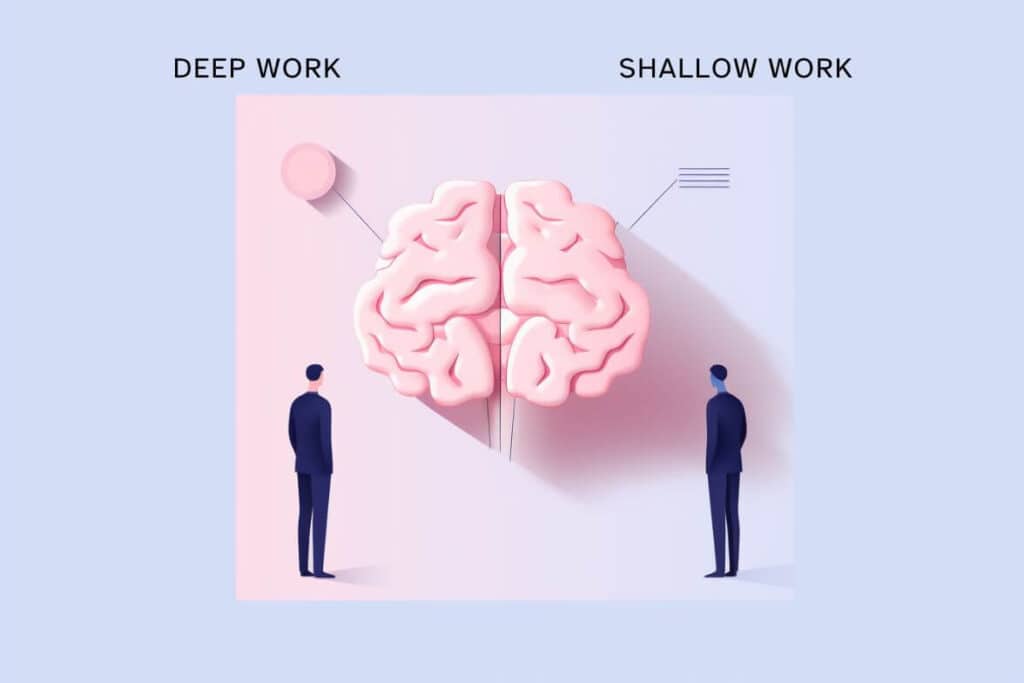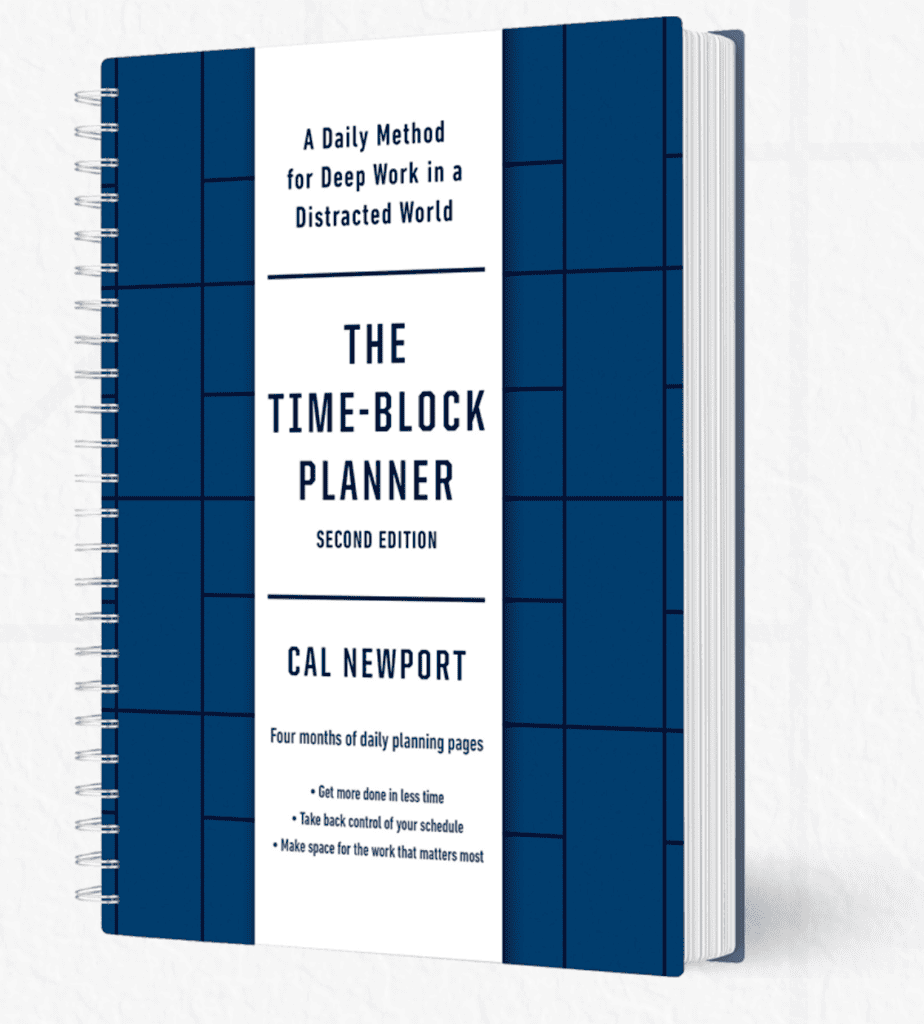Deep Work: Cal Newport Time Blocking Method Explained
Are your days a blur of tasks and to-do lists, leaving you feeling like you haven’t accomplished anything substantial?
Maybe the day gets away from you with a massive amount of shallow tasks, and the deep efforts needed for your projects fall by the wayside.
Fret not.
There’s a solution to help you navigate through this increasingly distracted world – Cal Newport’s Time Blocking method.
The computer science professor at Georgetown University has turned time management on its head by introducing a ‘day theming system’ that strategically batches tasks. Using a simple tool like a time block planner or a Google Calendar app, you can allocate specific hours to specific tasks, thus avoiding distractions and decision fatigue.
Imagine your day not as an open-ended reactivity but as a chess game of strategic moves, each designed to bring you closer to your professional goals.
The methodology is simple – you start time blocking by mapping out your day at a detailed level, which gives you a greater sense of control over your week ahead.
So, if the idea of having a productive day without the constant task switching appeals to you, read on. We’re about to dig deeper into the world of Cal Newport’s Time Blocking method.
From understanding the concept to the actual time planning pages, this blog post is your guide to adopting this approach to productivity.
Cal Newport’s Time Blocking In a Nutshell
Cal Newport Time Blocking method involves scheduling every minute of your day with specific tasks. This strategy enables you to focus on long, meaningful work while minimizing distractions and task-switching.
Read more in his article: Deep Habits: The Importance of Planning Every Minute of Your Work Day
What is Deep Work?
Deep Work, as defined by Cal Newport, is the ability to concentrate without distraction on a cognitively demanding task.
Sounds simple, right? But, in our increasingly distracted world, you’ll find it’s in fact quite difficult to implement.
Jumping between tasks (aka task switching) can significantly disrupt your focus, leading to poor productivity and output.
It’s like attempting to swim upstream—the current of distractions is working against you!
By committing to Deep Work, you’re essentially swimming with the current, allowing you to accomplish tasks in less time, with higher quality results.
Deep Work vs. Shallow Work

Deep Work and Shallow Work, two terms introduced by Cal Newport in his book, represent the two ends of the productivity spectrum.
Deep Work refers to cognitively demanding activities that require your full attention and are often directly tied to your professional value. For example, if you’re a software engineer, coding a new feature might constitute as Deep Work.
Shallow Work, on the other hand, relates to tasks that are not cognitively demanding and often have little value—think of scrolling through your email inbox or attending a meeting with no clear agenda. It’s like spending time arranging your chess pieces while the game is already in progress.
For instance, in my professional life, as an entrepreneur, writer and blogger, Deep Work could mean writing a complex blog post, while Shallow Work could be checking and replying to emails.
Four Rules of Deep Work
Now that you know what is the difference between Deep Work and Shallow Work, let’s look at how you can maximize your deep work capacity.
Drawing from Cal Newport’s book, here are the four rules of Deep Work that can revolutionize your productivity:
Rule 1: Work Deeply
Remember the last time you felt completely absorbed in a task, losing track of time? That’s the power of deep work. However, it’s not always easy to achieve this state.
Newport’s advice? Schedule breaks from distraction rather than focus. Only allow internet and phone access during designated times.
Just like you wouldn’t run a marathon without pacing yourself, don’t exhaust your brain by jumping between tasks. Stick to one thing for as long as you can, then completely switch off before moving on.
Rule 2: Embrace Boredom
The second rule advises us to cherish periods of boredom. Such moments, devoid of distractions, allow your mind the freedom to wander and create.
Newport suggests that rather than filling every free moment with screen time, allow yourself to just be. For instance, during a long wait in a queue, resist the urge to pull out your phone; instead, let your mind relax, ponder, and ideate.
Rule 3: Quit Social Media
Newport’s third rule is arguably the most challenging one: to quit social media. This doesn’t necessarily mean deleting all your social media accounts, but rather, approaching them with a craftsman mindset, valuing their usefulness against the time and energy they consume. I
f your online activities serve a significant purpose, keep them; if they don’t, it’s time to rethink your digital habits.
Rule 4: Drain the Shallows
The final rule encourages you to limit your engagement with shallow work – those tasks that are not cognitively demanding yet consume a lot of your time.
It’s about being mindful about how you spend your time and giving preference to deep, meaningful work over superficial tasks. This could mean learning to say no more often, setting boundaries for your availability, or even rethinking your commitment to unnecessary meetings.
How Deep Work Can Help You Improve Your Productivity
Now, let’s explore how ‘Deep Work’ can significantly enhance your productivity.
Uninterrupted Focus
Deep work ensures that you invest your time on a single task without any interruptions. It’s like reading a gripping novel – you’re so engrossed, you lose track of time and suddenly, you’re done!
Quality Over Quantity
Deep work isn’t about how many tasks you do, but how well you do them. This focus on quality over quantity yields better results.
Mastering New Skills
Deep work sessions are perfect for learning new skills. With distraction-free learning, you can master that new language or coding skill you’ve been eyeing.
Let’s not forget Cal Newport’s own practice: he dedicates uninterrupted hours to deep work each day, a strategy that has significantly boosted his productivity.
Unleashing the Power of Deep Work with Time Blocking
Now that you’ve got the hang of what Deep Work is all about, you might be scratching your head, wondering how to fit this into your daily hustle. That’s where Time Blocking comes in to save the day! This easy-to-use strategy is just what you need to put Deep Work into practice. Let’s dive into how Time Blocking can turn you into a master of Deep Work.
Take Charge of Your Day
Think about it. Time Blocking gives you control over your own day. No more feeling swamped by a to-do list that spirals out of control. Instead, you set up specific time slots for each task. It’s like having a map of your day, so you always know where you’re heading next.
No More Multitasking
Time blocking means you’re done trying to spin too many plates at once. Deep Work is all about focus, not juggling. Think about it. You wouldn’t try to watch a movie and read a book at the same time, would you? It’s all about one task at a time.
In Sync with Deep Work
Time Blocking is really in tune with the principles of Deep Work. It’s all about shutting out distractions and diving into a single task, just like Cal Newport promotes. By the way, Newport is a huge advocate for Time Blocking. He even crafted a Time-Block Planner to help others get into Deep Work.
More on that later.
Time Blocking for Decision Fatigue and Distractions
Frequent decision-making and distractions are two major challenges in achieving deep work. Cal Newport’s time-blocking principles provide a robust framework to tackle these issues head-on. Avoid decision fatigue by pre-planning your workday.
Knowing what to work on and when reduces cognitive load and boosts focus. As for distractions, maintaining a ‘shutdown ritual’ at the end of each workday can be helpful. This practice trains your brain to disassociate from work-related thoughts, reducing the risk of burnout and aiding recovery.
Time Blocking: A Step-By-Step Guide
Let’s break down how to create and use a time-blocking schedule for maximum productivity:
Step 1: Set Up Your Time Blocking Sheet
First, grab a lined sheet of paper.
Down the left margin, list the hours of your typical work day, leaving space for half-hour increments. This step gives you a clear, visual representation of your workday, with each line standing for 30 minutes of your time.
Step 2: Divide Your Day into Blocks
Next, break down your workday into manageable time blocks. These are your dedicated chunks of time for specific tasks or activities.
Planning to work on an article for your website from 9 am to 11 am?
Draw a box spanning that timeframe and label it “blog post”. Continue this process for the rest of your workday, including time for meetings, email management, projects, and other tasks.
Step 3: Set a Minimum Time Block of 30 Minutes
To keep things organized and structured, make sure each time block is at least 30 minutes. If a task takes less time than that, create a “task block”.
Draw a vertical line on the right, creating a separate column. Here, list smaller tasks that can be tackled within that time frame.
Step 4: Fill Your Schedule Completely
The key to time blocking is accounting for every minute of your workday. Fill your time-blocking sheet from the moment your workday starts to when it ends.
By assigning each minute a purpose, you reduce the chances of getting sidetracked or falling into unproductive activities.
Step 5: Follow Your Time Block Schedule
Once your time-blocking sheet is set up, follow it as closely as possible. Let your time blocks guide your workflow and direct your focus. It’s a powerful tool to ensure you stay productive and maintain a deep work mindset.
Adhering to a structured time-blocked schedule aligns perfectly with the principles of deep work. And if you’re looking for a convenient solution that eliminates the need to manually map out your schedule, Cal Newport has designed a dedicated planner for this purpose.
Cal Newport’s Time-Block Planner

If you’re seeking an effective solution to enhance your productivity in a world full of distractions, Cal Newport’s The Time-Block Planner: A Daily Method for Deep Work in a Distracted World, is your answer.
This practical planner is based on the powerful concept of time-blocking – a technique used by highly successful individuals like Elon Musk and Bill Gates and endorsed by productivity experts Peter Drucker and Benjamin Franklin.
Key Features of Cal Newport Time Block Planner:
- Core concept involves partitioning work hours into activity blocks, promoting deep work and efficient task batching.
- Provides 90 days’ worth of time-blocking pages with daily grid layouts, offering flexibility for scheduling adjustments.
- Includes weekly planning pages featuring productivity insights from Cal Newport, facilitating strategic week planning.
- Features a “shutdown” box at the top of each page, promoting effective end-of-day rituals.
- “The Time-Block Planner” is a valuable tool for prioritizing deep work, minimizing distractions, and enhancing professional productivity.
Tools and Resources for Time Blocking and Deep Work
While paper planners like the Time-Block Planner are excellent tools for time-blocking, several digital resources can also aid in enhancing productivity.
- Google Calendar: A straightforward, visually appealing tool that allows you to plan your day meticulously. It’s great for setting reminders for crucial tasks. However, it may be less effective for those seeking more detailed time-blocking features. Learn how to use Google Calendar for time blocking.
- Notion: Notion shines with its customization options. You can tailor it to be the digital planner of your dreams. On the flip side, this means there’s a steeper learning curve to fully understand its features.
- Google Sheets: For spreadsheet enthusiasts, Google Sheets is a fantastic tool. You can color-code tasks, track your progress, and collaborate with others.
- Trello: This project management tool utilizes a card system, making it perfect for visual time blocking. But, its lack of traditional calendar view might be a setback for some.
Remember, successful time blocking requires discipline and consistency. Choosing a tool that suits your habits and preferences can make the process smoother and more enjoyable.
Frequently Asked Questions (FAQ)
Q1. How can I start time blocking, especially if I have a busy schedule?
To begin time blocking, allocate blocks of time to your most important tasks. Start small, like with one-hour blocks, and gradually expand.
Prioritize tasks that matter, and use a calendar app to schedule and track your progress.
Q2. What are some examples of tasks that I can accomplish more effectively through Deep Work?
Tasks that require a high level of focus, such as writing, programming, or deep research, are excellent candidates for Deep Work.
Q3. How much time should I dedicate to Deep Work, and should it be the same amount every day?
The ideal time for Deep Work varies among individuals. While Cal Newport suggests aiming for 4 hours per day, it doesn’t have to be the same amount daily. Adjust your Deep Work time based on your goals, tasks, and work demands.
Q4. How can I minimize distractions during Deep Work sessions?
To minimize distractions, create a dedicated workspace, turn off notifications on your devices, and communicate your Deep Work schedule to colleagues or family. Consider using website blockers and time management apps to stay on track.
Q5. Is it better to schedule Deep Work sessions daily or intermittently?
The frequency of Deep Work sessions depends on your job and preferences. Some people find daily sessions effective, while others prefer scheduling them intermittently, such as 2-3 times a week. Experiment to find what works best for you.
Q6. What strategies can most knowledge workers use to stay focused during Deep Work sessions?
Knowledge workers can implement strategies like the day theming system, setting professional life boundaries, and planning tasks for the upcoming week.
These techniques help in making deep efforts on long tasks and specific tasks while minimizing distractions from similar tasks.
Bottom Line
So you’ve made it this far!
It’s clear that you’re serious about stepping up your productivity game. Let’s quickly recap our key takeaways:
- Doing focused, deep work can greatly improve your productivity.
- Plan your day using time blocking to ensure important tasks get done.
- Reserve deep work sessions for tasks that demand your full attention, like writing or coding.
- Minimize distractions by silencing your phone, communicating your work schedule, and using website-blocking tools.
Now, it’s over to you! Remember, it’s a journey, not a sprint, so take it one step at a time and enjoy the process.
Resources:
Newport, C. (2016). Deep Work: Rules for Focused Success in a Distracted World. Grand Central Publishing.
“Multitasking: Switching costs.” (2006). American Psychological Association. https://www.apa.org/research/action/multitask
https://www.calnewport.com/books/deep-work/
https://www.calnewport.com/blog/2014/11/21/deep-habits-the-danger-of-pseudo-depth/







